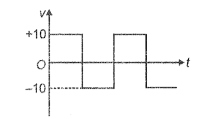If and are half power frequencies of a series LCR circuit, then resonant frequency can be expressed as
Hence:
| 1. | The voltage leads the current by \(30^{\circ}\). |
| 2. | The current leads the voltage by \(30^{\circ}\). |
| 3. | The current leads the voltage by \(60^{\circ}\). |
| 4. | The voltage leads the current by \(60^{\circ}\). |
The r.m.s. voltage of the waveform shown is:

1. 10 V
2. 6.37 V
3. 7 V
4. 10.5 v
1. \(50~\text{V}\)
2. \(50\sqrt{2}~\text{V}\)
3. \(\frac{50}{\sqrt{2}}~\text{V}\)
4. \(\frac{100}{\pi}~\text{V}\)
Voltage and current in an A.C. circuit is given by
Wattful current in the circuit is-
Which of the following devices is not based on Faraday's law of electromagnetic induction?
1. AC generator
2. Speedometer
3. Induction motor
4. DC motor
Current l through an inductor is increasing according to . Variation of the rate of increment of its energy with time t is correctly shown in the graph
1. 
3. 
A time-varying current is given by Its r.m.s. value is (symbols have usual meanings)
An alternating voltage at different frequencies is applied across a capacitor C as shown in the figure. Which of the following graphs between RMS current observed by an ammeter and angular frequency of voltage is correct?
1. 
3. 
| 1. | \(V_r=V_L>V_C\) |
| 2. | \(V_R \neq V_L=V_C\) |
| 3. | \(V_R \neq V_L \neq V_C\) |
| 4. | \(V_R=V_C \neq V_L\) |











